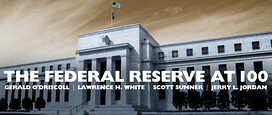In his most recent reply, Gerald O’Driscoll has some provocative comments on monetary policy:
In a gold or other commodity standard world, central banks cannot generate inflation if they want to stay on the standard. The price level is determined globally by the operation of the commodity standard. It might be better to say there is no monetary policy on a commodity standard.
It is certainly true that monetary policy is greatly limited under a gold standard. But it’s worth noting that “inflation” is not the only possible monetary policy. The major central banks can and did enact highly contractionary monetary policies during the early 1930s. They did this by sharply raising the ratio of gold to currency, in other words by hoarding massive quantities of gold.
Mr. O’Driscoll is also skeptical of proposals to raise the inflation target, and he makes this observation about price inflation:
We have low (not no) price inflation, conventionally measured. But conventional measures are misleading. They exclude asset prices, and by that measure, there are quite strong inflationary pressures.
Again I partly agree and partly disagree. I certainly agree that inflation is a misleading indicator of the stance of monetary policy. I also agree with Mr. O’Driscoll that it would be a mistake to target a higher rate of inflation. However, I don’t think asset prices are a good indicator either. The real interest rate on 10-year Treasury bonds has been falling for more than three decades, from over 7% to roughly zero. This is clearly not the result of an expansionary monetary policy, as nominal GDP growth (M*V) has also slowed sharply. The lower real interest rates have pushed asset prices much higher for reasons unrelated to monetary policy. Note that low long term real rates are a “fundamental” factor, and hence high assets prices are not necessarily a bubble. In my view nominal GDP growth is the most reliable indicator of the stance of monetary policy, and by that indicator policy has been tighter since mid-2008 than at any other time since Herbert Hoover was president.
Mr. O’Driscoll then points out correctly that monetary stimulus in the United States can result in excessive inflation in countries with currencies pegged to the dollar, such as Hong Kong. But I’m not convinced by this argument:
As John Taylor and others have argued, even central banks that maintain a floating exchange rate against the U.S. dollar cannot realistically fight Fed policy. To do so would cause a crippling appreciation of the exchange rate of the local currency. Hence, the Fed is exporting global asset-price inflation.
If countries with floating exchange rates target nominal GDP growth, then any currency appreciation resulting from the weak dollar will not be “crippling.” In my view the global asset price inflation is coming from a drop in global real interest rates, produced by the same factors that are lowering U.S. real interest rates.
One of the most interesting questions facing monetary policymakers today is the causes and consequences of ultra-low interest rates. I think people like Larry Summers and Paul Krugman are basically correct in their diagnosis of the problem. Structural changes in savings and investment, combined with a 2% inflation target, have made low nominal interest rates the “new normal.” Rates are likely to fall to zero in the next few recessions as well. However I don’t think their solutions are the right way to go. Rather than employing fiscal stimulus, or raising the inflation target, we need to think about a policy of level targeting so that monetary policy remains effective even when interest rates are near zero. Thus I believe we need to find a “third way” between traditional Keynesian arguments and more conservative claims that low nominal interest rates represent an easy money policy.
It is also important to recognize that monetary policy is a “blunt instrument,” not well-suited to popping asset price bubbles. If I’m not mistaken, the only time the Fed ever tried to use monetary policy to pop an asset bubble was in 1929. In that year they continually raised interest rates. At first stock prices continued increasing despite the higher interest rates. Only when interest rates got so high that they drove the economy into a depression did stock prices start falling. In 2011 the European Central Bank tried to move away from very low interest rates by raising their target rate modestly. Unfortunately this drove the eurozone into a double dip recession and they had to cut interest rates back close to zero. Policymakers need to keep their eye on nominal GDP growth.

